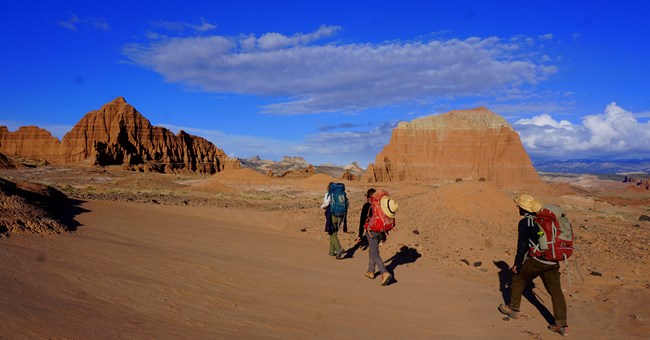
NPS
The Northern Colorado Plateau Network monitors air quality, climate, invasive exotic plants, land surface phenology, landbirds, landscape dynamics, uplands, wadeable streams, and water quality at Capitol Reef National Park. The results of that monitoring provide park managers with scientific information for decisionmaking.
Before becoming a national park in 1971, Capitol Reef National Park was established as Capitol Reef National Monument by Presidential Proclamation in June 1937, to reserve in the public interest "narrow canyons displaying evidence of ancient sand dune deposits of unusual scientific value, and . . . various other objects of geological and scientific interest." The park is best known for the geologic wonders of the Waterpocket Fold, the Cathedral Valley, narrow canyons, and evidence of ancient sand-dune deposits.
Elevation varies from 2,731 meters (8,960 feet) on Thousand Lake Mountain in the northwest section to 1,183 meters (3,880 feet) in Halls Creek at the southern tip. The park supports a patchwork of terrain, life zones, and habitats in which even slightly different combinations of slope, aspect, exposure, elevation, moisture, mineral content, and other variables blend to create distinctive microclimates and narrow niches. Woodlands and forests are common, occupying nearly every available habitat.
Shrublands are the most diverse plant communities. Herbaceous plant communities are common but patchy, and the distribution of riparian and wetland communities is limited. Past livestock grazing has altered the composition and structure of many grassland and riparian communities. The Fremont River flows through the park, its hydrology altered by the construction of a highway across a meander of the river in 1964, cutting off an old river oxbow.
Livestock grazing, increasing recreational use, collection and theft of rare and listed plants, adjacent land-use impacts, and exotic plant species invasion are the park's main natural resource management concerns.
Quick Reads
Publications
Source: NPS DataStore Saved Search 3765. To search for additional information, visit the NPS DataStore.
Source: NPS DataStore Saved Search 3766. To search for additional information, visit the NPS DataStore.
Last updated: June 11, 2025
